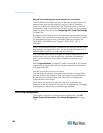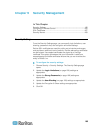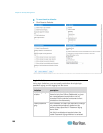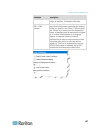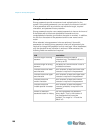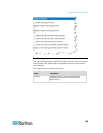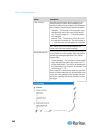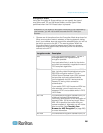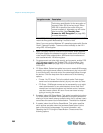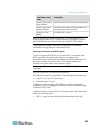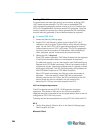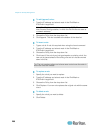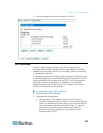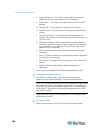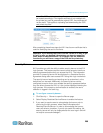
Chapter 9: Security Management
202
Encryption mode
Description
a National Institute of Standards and
Technology specification for the encryption of
electronic data. 256 is the key length. When
AES-256 is specified, be certain that your
browser supports it, otherwise you will not be
able to connect. See Checking Your
Browser for AES Encryption (on page 203)
for more information.
Note: MPC will always negotiate to the highest encryption and will
match the Encryption Mode setting if not set to Auto.
Note: If you are running Windows XP
®
operating system with Service
Pack 2, Internet Explorer
®
7 cannot connect remotely to the KX II
using AES-128 encryption.
2. Apply Encryption Mode to KVM and Virtual Media. When selected,
this option applies the selected encryption mode to both KVM and
virtual media. After authentication, KVM and virtual media data is
also transferred with 128-bit encryption.
3. For government and other high security environments, enable FIPS
140-2 Mode by selecting the Enable FIPS 140-2 checkbox. See
Enabling FIPS 140-2 (on page 204) for information on enabling
FIPS 140-2.
4. PC Share Mode. Determines global concurrent remote KVM access,
enabling up to eight remote users to simultaneously log into one KX
II and concurrently view and control the same target server through
the device. Click the drop-down list to select one of the following
options:
Private - No PC share. This is the default mode. Each target
server can be accessed exclusively by only one user at a time.
PC-Share - KVM target servers can be accessed by up to eight
users (administrator or non-administrator) at one time. Each
remote user has equal keyboard and mouse control, however,
note that uneven control will occur if one user does not stop
typing or moving the mouse.
5. If needed, select VM Share Mode. This option is enabled only when
PC-Share mode is enabled. When selected, this option permits the
sharing of virtual media among multiple users, that is, several users
can access the same virtual media session. The default is disabled.
6. If needed, select Local Device Reset Mode. This option specifies
which actions are taken when the hardware Reset button (at the
back of the device) is depressed. For more information, see
Resetting the KX II Using the Reset Button. Choose one of the
following options:



